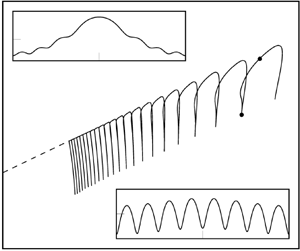Article contents
On the structure of steady parasitic gravity-capillary waves in the small surface tension limit
Published online by Cambridge University Press: 09 July 2021
Abstract

When surface tension is included in the classical formulation of a steadily travelling gravity wave (a Stokes wave), it is possible to obtain solutions that exhibit parasitic ripples: small capillary waves riding on the surface of steep gravity waves. However, it is not clear whether the singular small surface tension limit is well posed. That is, is it possible for an appropriate travelling gravity-capillary wave to be continuously deformed to the classic Stokes wave in the limit of vanishing surface tension? The work of Chen & Saffman (Stud. Appl. Maths, vol. 62, issue 1, 1980, pp. 1–21) had suggested smooth continuation was not possible, while the numerical study of Schwartz & Vanden-Broeck (J. Fluid Mech., vol. 95, issue 1, 1979, pp. 119–139) used an amplitude parameter that made it difficult to understand the structure of solutions for small values of the surface tension. In this paper we numerically explore the low surface tension limit of the steep gravity-capillary travelling-wave problem. Our results allow for a classification of the bifurcation structure that arises, and serve to unify a number of previous numerical studies. Crucially, we demonstrate that different choices of solution amplitude can lead to subtle restrictions on the continuation procedure. When wave energy is used as a continuation parameter, solution branches can be continuously deformed to the zero surface tension limit of a travelling Stokes wave.
- Type
- JFM Papers
- Information
- Copyright
- © The Author(s), 2021. Published by Cambridge University Press
References
REFERENCES
- 7
- Cited by



